By David D. Taylor
This article expands on Invasive Plant Corner – Bush Honeysuckle (Lonicera Spp.), in the April 2020 issue.
Amur honeysuckle (Lonicera maackii) is the most widespread and arguably the most invasive of the nonnative invasive honeysuckle shrubs in Kentucky. Jeff Nelson’s article on Amur honeysuckle provides a general overview of the species. This article provides some details as to why this species is so invasive and why is an ecologically undesirable species.
Amur honeysuckle, native to central and northeastern China, Japan (rare), Korea, and far eastern Russia, occurs as an understory shrub in open hardwood and mixed hardwood-conifer forest consisting of oaks, elms and other hardwoods and fir, spruce and hemlock. It is also known from and more common in riparian and scrub communities (Luken and Thieret 1996). It grows as scattered individual shrubs or small clumps, not unlike viburnums do in Kentucky. Large, dense stands do not typically occur, but in open, riparian areas it can be weedy. In its native range, individuals typically do not exceed 4 inches diameter and 20 feet tall (Yang et al. 2011). In Kentucky, the species is often an understory shrub in open forest, but forms dense thickets at forest edge, along fence rows and in open areas. It grows larger here as well, to 6 inches diameter and 30 feet tall (personal observation).
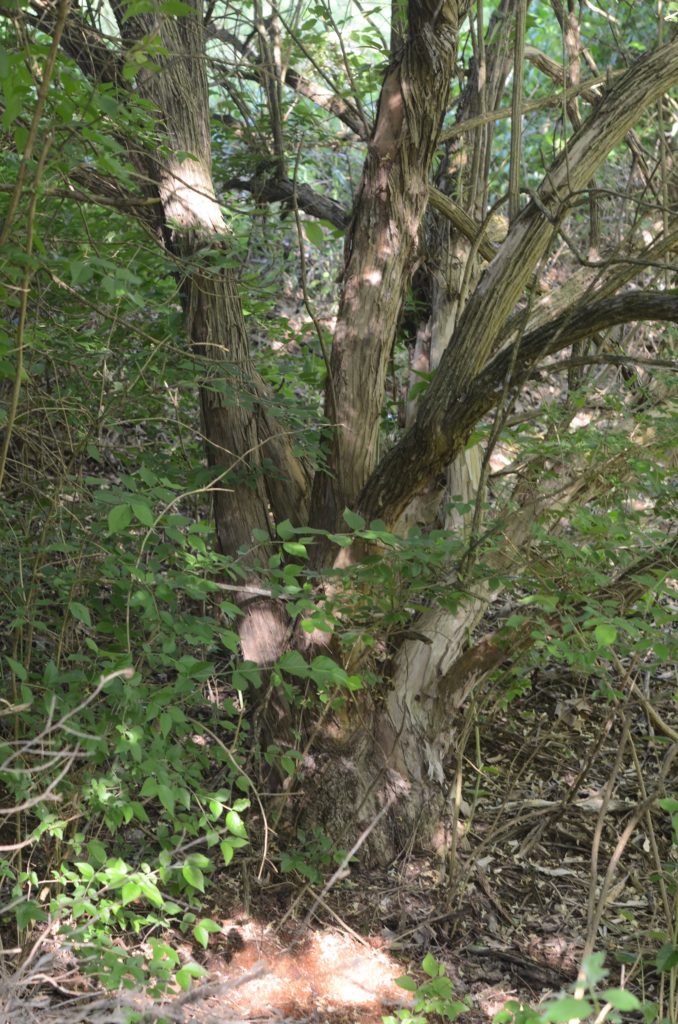
29 April 2020.
Photo by David Taylor
This shrub leaves out early in spring, often breaking bud in mid-March, long before native trees and shrubs. By mid-April of most years, leaves are fully expanded, and the shrubs are actively growing. In the fall, Amur honeysuckle typically senesces (leaves turn yellow and drop) in late October to mid-November, and sometimes not until early December. Native trees and shrubs typically break bud late March to mid-April and do not fully expand until early May. In eastern Kentucky, they are actively dropping their leaves by mid- to late October in most years. The extra 5-8 weeks of photosynthetic activity in the honeysuckle allows it to store additional energy giving it an edge over native species (McEwan et al. 2009). It is also somewhat tolerant of late freezes. Both promote its invasive nature.
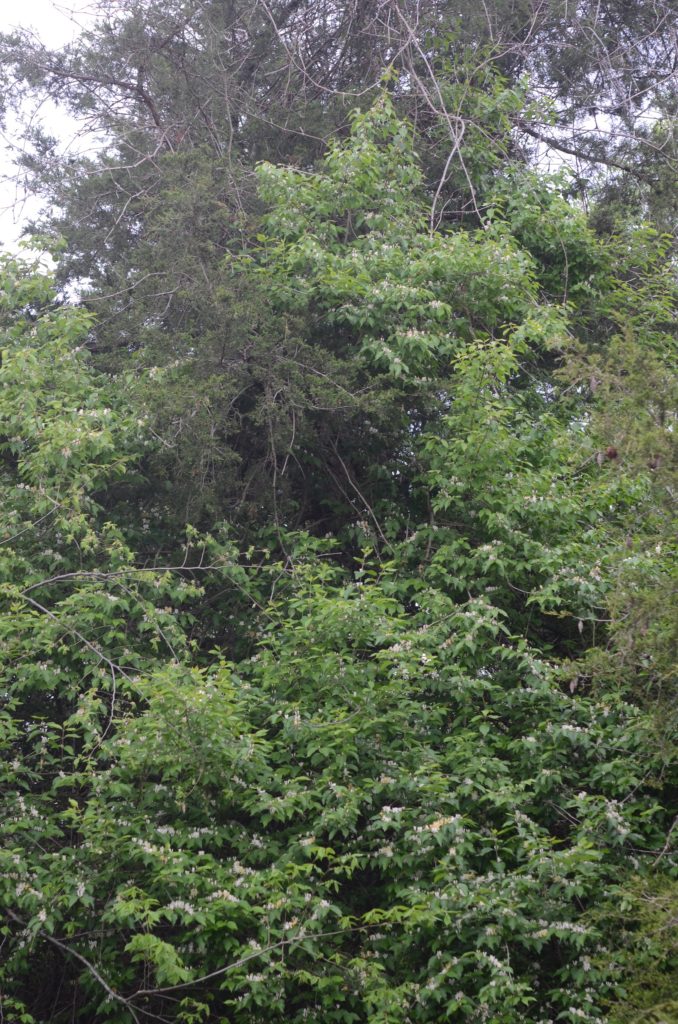
29 April 2020.
Photo by David Taylor
While Amur honeysuckle grows better in full sun (Luken 1995), it is known to survive in 1 percent of full sunlight in the heavy shade of trees (Luken et al. 1997a). The native spring flowering spice bush (Lindera benzoin) by comparison, requires about 25 % of full sun to survive (Luken et al. 1997a). Forest grown Amur honeysuckle under heavy shade tends to produce few stems which grow upward toward light specks. They tend not to have much branching, nor do they attain much diameter. In the open, individual shrubs produce numerous stems and branching is extensive. Maximum diameters are obtained in the open (Luken et al 1995a). Overtopped Amur honeysuckle shrubs respond with the production of long, upright stems that seek light. Honeysuckle in open forest may branch extensively and produce heavy shade.
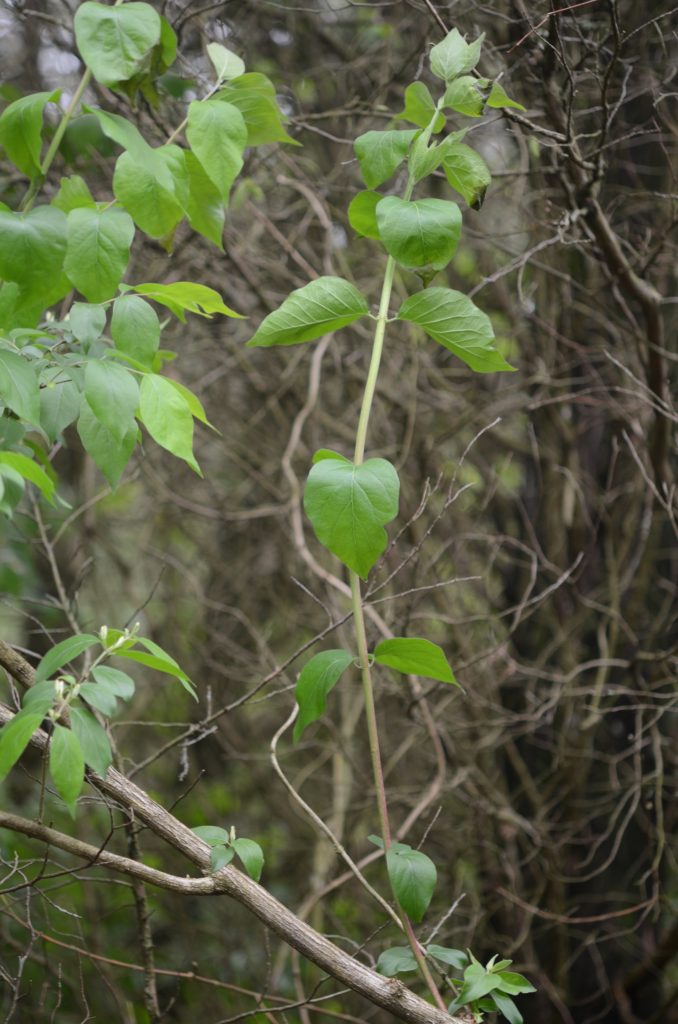
24 April 2020.
Photo by David Taylor
Stems grow rapidly, up to 5 feet per year for the upright, light seeking stems (personal observation). The rapid growth allows shrubs to grow through denser vegetation to find light. When in adequate light, stem growth is branching to capture as much light as possible. With time, this results in heavy shading of the ground and any stems underneath. As a result, Amur honeysuckle kills some of its own stems, leaving an intertwined mass of dead branches under the live ones. The shade from the leaves and stems can effectively prevent germination and or growth of not only native shrub and tree seedlings, but also herbaceous species. This effectively reduces competition and gives the shrub another ecological advantage. Collier et al. (2002) working in SW Ohio found that when looking at all species growing under Amur honeysuckle, there was a 53% lower richness, and a 63% lower cover of all species, and a 41% lower richness of tree seedlings than in areas without honeysuckle. Hartman and McCarthy (2004), also working in SW Ohio, found tree seedling survival was 32% lower in areas invaded by the shrub than in areas without the shrub. Hartman and McCarthy (2008) later found that the longer Amur honeysuckle had been in an area, the more the species composition under honeysuckle differed from uninvaded areas. Hutchinson and Vankat (1997), also working in SW Ohio, found a similar effect of honeysuckle, but with a twist. The more sugar maple present, the less honeysuckle was present. The maple was creating shade dense enough to limit honeysuckle growth. Runkle et al. (2007) showed that some recovery of species richness, cover and tree seedling densities can occur following honeysuckle removal after a lag period of at least one year, while Swab et al. (2008) did not find this to be the case in a bottomland hardwood forest after several years of honeysuckle removal. Success of native species return may depend on site and length of time honeysuckle has been present.
The presence of Amur honeysuckle even reduces the growth of midstory and overstory trees. Hartman and McCarthy (2007) found a nearly 16% reduction in basal area (the area of the tree’s cross section at ground level) growth when the honeysuckle was present. Additionally, they found a reduction of 53% in the rate of basal area growth across the forest area. Using dendrochronology techniques, they determined that significant reduction in growth first occurred about 6 years after honeysuckle invaded the forest. After 20 years of invasion, growth reduction was evident across the forest area.
The leaves of Amur honeysuckle are known to produce phenolic compounds (Cipollini et al 2008, Cipollini and Dorning 2008, Dorning and Cipollini 2006) and phenolic compounds can affect plants. These are produced by plants to deter herbivory, but also can have allelopathic effects on plants. Several researchers have tested the effect of leaf extracts of Amur honeysuckle on seed germination and plant growth (Dorning and Cipollini 2006, Cipollini et al. 2007, McEwan et al. 2010). Seed germination of several species was reduced or delayed in the presence of honeysuckle leaf extract, but not in the leaf extract of native shrubs. Amur honeysuckle seeds were not affected by either kind of extract but are suppressed by lack of light (Luken and Thieret 1997), although germination will occur without light (Luken and Goessling 1995). Cipollini and Dorning 2008, looking at the test plant mouseear cress (Arabidopsis thaliana) growing in soil that had come from under honeysuckle found slowed growth, delayed flowering and more seed production than compared to soil from uninvaded sites. Miller and Gorchov (2004) in contrast suggested that there was no apparent allelopathic effects on the native forest herbs they studied. Rather it appeared to be loss of light over time that resulted in species loss. Invaded sites are often without vegetation underneath the shrub or the species present are generalist in nature (Luken et al. 1997). Fruits have also been shown to have allelopathic effects (McEwan et al. 2010).
The phenolic compounds mentioned above also affect animals. Watling et al. (2011a) showed that leaf extracts negatively affected some amphibians, increasing larval mortality or decreasing respiratory efficiency. Berta (2019) showed that Amur honeysuckle in artificial ponds resulted in high mortality of spotted salamander (Ambystoma maculatum) larvae. Watling et al. (2011b) demonstrated that Amur honeysuckle leaf extract accelerated the development of American toad (Anaxyrus americana) larvae. Watling et al. (2011c) reported reduced species richness and evenness along with changes in the amphibian communities of forest where Amur honeysuckle had invaded. Hickman and Watling (2014) found that American toad larvae exhibited risky behavior in the presence of predator clues when exposed to leachate from Amur honeysuckle leaves.
White and Stiles (1992) showed that overall bird use of fruits declined fall to winter, but the relative use of nonnative fruits increased in the same time period. Amur honeysuckle produces fruits in abundance, especially open grown shrubs. The red fruits are bitter, and largely sugar water with relatively low nutritional value, but are attractive to and are eaten by a variety of birds when native foods sources are depleted (Ingold and Craycraft 1983, Gledtisch and Carlo 2011). Birds spread viable seed (Bartuszevige and Gorchov 2006), typically into areas with some light which encourages germination in the spring (Hoppes 1988). Birds also nest in Amur honeysuckle because it provides early leaf cover. Nonetheless, nest predation and parasitism in honeysuckle shrubs is high and successful fledging is reduced (Schmidt and Whelan 1999, Borgmann and Rodewald 2004, Rodewald 2009, Rodewald et al. 2010). Small mammals, in particular deer mice (Peromyscus spp.) have been shown to consume the fruit and may spread the seed (Batcher and Stiles 2000, Dutra et al. 2011). Additionally, Meiners (2007) reported that seeds of native trees were more likely to be eaten, mostly by white-footed deer mice (Peromyscus leucopus), when in the presence of Amur honeysuckle.
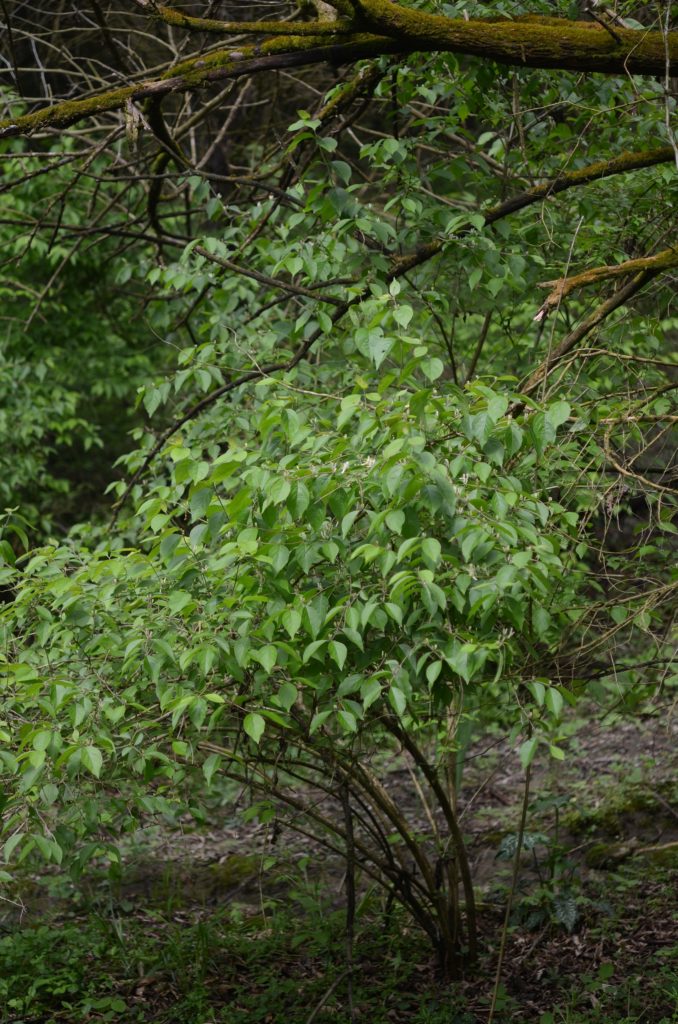
24 April 2020.
Photo by David Taylor
Both birds, in particular American robin (Turdus migratorius), and white-tailed deer (Odocoileus virginianus) serve as long distance spreaders of Amur honeysuckle, especially to edge habitat where the shrub reaches its best growth (Bartuszevige and Gorchov 2006, Gledtisch and Carolo 2011, Castellano and Gorchov 2013). Deer are attracted to Amur honeysuckle (Dutra 2011), consume honeysuckle leaves and young twigs and they also ingest the fruit (Peebles-Spencer 2016). Nearly 70% of the seeds of this honeysuckle consumed by deer are still viable after passing through the intestines (Castellano and Gorchov 2013). Related to the presence of deer, areas invaded with Amur honeysuckle have a higher tick load than areas without it (Dutra 2011, Christopher and Cameron 2012). The number of disease carrying ticks was also greater in areas with honeysuckle than in areas without it (Allan et al. 2010, Dutra 2011).
Mosquitoes are also affected by Amur honeysuckle. Muturi et al. (2015) found that Culex restuans, a native mosquito, and a vector for both St. Louis encephalitis and West Nile virus, was more abundant in artificial pools with Amur honeysuckle leaf litter than pools with native leaf litter. Gardner et al. (2015) and Shewhart et al. (2014) found significantly more Culex pipiens, an introduced vector for West Nile virus, emerged from artificial pools containing Amur honeysuckle leaves more consistently than from pools containing native shrub leaves. Native blackberries, conversely acted as an ecological trap for the species. Aedes albopictus, an introduced vector of chikungunya virus, dengue virus and dirofilariasis, grew faster in the presence of Amur honeysuckle leaves than in the presence of native leaves (Russo and Boyd 2018). Dense larval populations fared better with honeysuckle leaves than native leaves. Adults from larvae influenced by honeysuckle also grew larger. However, pools with native leaves were more likely to produce adult mosquitoes.
The leaves of Amur honeysuckle contain more nitrogen and less lignin than some native trees (Arthur et al. 2012, Poulette and Arthur 2012). This results in a more rapid decomposition of honeysuckle leaves. However, decomposition under honeysuckle is slower than away from honeysuckle. The net effect is an increase in nitrogen in the soil and litter (Kolbe et al. 2015) and an altering of the immediate microbial community (Arthur et al. 2012). Blair and Stowasser (2009) noted that exotic earthworms, which also alter nutrient composition of soils, were more abundant under invasive shrubs than under native species. They and Poulette and Arthur (2012) also suggested that whatever nitrogen was present in the soil in spring was rapidly taken up by Amur honeysuckle before other species began to grow. This in turn could contribute to the loss of species diversity in invaded areas. In streams, honeysuckle leaves breakdown rapidly leaving a reduced supply of organic matter which altered the macroinvertebrate community (McNeish et al. 2012).
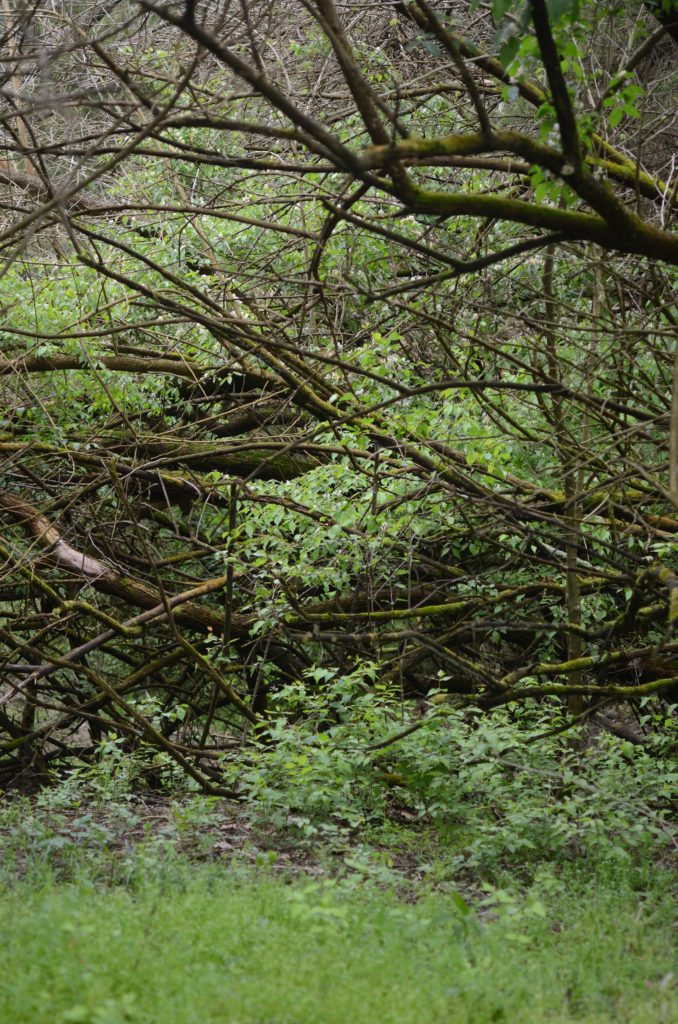
24 April 2020.
Photo by David Taylor
Over about 20 years, researchers have investigated various effects of the invasive Amur honeysuckle on the environment of the eastern deciduous forest. Much has been learned, but much is not understood. It is known to negatively affect the growth and germination of many native and non-native plants including trees. It provides low quality fruit that attract birds which in turn plant more of the shrub. It induces birds to nest in its branches where they are easily predated and parasitized reducing yearly reproduction. The plant attracts white-tailed deer and with that comes an increase in tick density and number of ticks carrying diseases. It affects the development and behavior of some amphibians and it promotes the development of disease-carrying mosquitoes. The leaf litter of the shrub alters decomposition rates, nitrogen content and microbial activity in the soil, which in turn help the honeysuckle and hurt some native plants. This plant, introduced for its horticultural value, has become an ecological disaster. It is widespread and continues to spread. Efforts to remove it should continue among individual property owners and land managers.
David has been interested in plants since elementary school. During middle and high school years, he began a list of the plants found in the fields and forest near his home. He also began to grow wildflowers in a garden that his mother soon adopted. At Berea College, he was exposed to formal botany classes and began to collect extensively (with permission) in the Berea College Forest, updating a much earlier collection. In graduate school, he completed a preliminary flora of St. Tammany and Washington Parishes, Louisiana. After teaching at Cumberland College for two years, he joined the U.S. Forest Service as Forest Botanist for the Daniel Boone National Forest. He has been in that position for more than 30 years working primarily with rare plants and nonnative invasive plants.
David has worked with the Kentucky Native Plant society for about 30 years, serving mostly as grants chairperson. He has contributed about a dozen articles to The Lady Slipper over the years. David lives outside of Berea, where he grows a variety of plants and works to remove invasive species from grown up pasture land.
Literature Cited
Allan, B.F, H.P. Dutra, L.S. Goessling, K. Barnett, J.M. Chase, R.J. Marquis, G. Pang, G.A. Storch, R.E. Thach, and J.L. Orrock. 2010. Invasive honeysuckle eradication reduces tick-borne disease risk by altering host dynamics. PNAS 107(43):18523-18527.
Arthur, M.A., S.R. Bray, C.R. Kuchle, and R.W. McEwan. 2012. The influence of the invasive shrub, Lonicera maackii, on leaf decomposition and microbial community dynamics. Plant Ecol. 213:1571-1582.
Batcher, M.S. and S.A. Stiles. 2000. Element Stewardship Abstract for Lonicera maackii (Rupr.) Maxim (Amur honeysuckle) Lonicera morrowii A. Gray (Morrow’s honeysuckle) Lonicera tatarica L. (Tatarian honeysuckle) Lonicera x bella Zabel (Bell’s honeysuckle). The Nature Conservancy, Arlington, VA. Available at https://www.invasive.org/gist/esadocs/documnts/loni_sp.pdf. Accessed 27 April 2020.
Berta, J.L. 2019. Ecosystem functional consequences of top predator mortality due to the invasive shrub, Lonicera maackii. Master’s Thesis. Eastern Kentucky University. 61 p. Available at https://encompass.eku.edu/cgi/viewcontent.cgi?article=1588&context=etd. Accessed 25 April 2020.
Blair, B.C. and A. Stowasser. 2009. Impact of Lonicera maackii on Decomposition Rates of Native Leaf Litter in a Southwestern Ohio Woodland. Ohio J. Sci 109(3):43-47.
Borgmann, K.L. and A.D. Rodewald. 2004. Nest predation in an urbanizing landscape: the role of exotic shrubs. Ecol. Appl. 14: 1757–1765.
Collier, M.H., J.L. VanKat, and M.R. Hughes. 2002. Diminished plant richness and abundance below Lonicera maackii, an invasive shrub. Am. Mid. Nat. 147(1):60-71.
Cipollini, D. and M. Dorning. 2006. Direct and indirect effects of conditioned soils and tissue extracts of the invasive shrub, Lonicera maackii, on target plant performance. Castanea 73(3):166-176.
Cipollini, D., R. Stevenson, S. Enright, A. Eyles, and P. Bonello. 2008a. Phenolic metabolites in leaves of the invasive shrub, Lonicera maackii, and their potential phytotoxic and anti-herbivore effects. J. Chem. Ecol. 34:144-152.
Cipollini, K.A., G.Y. McClain, and D. Cipollini. 2008b. Separating above- and belowground effects of Alliaria petiolata and Lonicera maackii on the performance of Impatiens capensis. Am. Mid. Nat. 160(1):117-128.
Dorning, M. and D. Cipollini. 2006. Leaf and root extracts of the invasive shrub, Lonicera maackii, inhibit seed germination of three herbs with no autotoxic effects. Plant Ecol. 184(2):287-296.
Dutra, H.P. 2011. Effects of the exotic shrub, Lonicera maackii on the plant and an animal interactions in the invaded habitat. Dissertation. University of Missouri, St. Louis. 159 p. Available at irl.umsl.edu/cgi/viewcontent.cgi?article=1387&content=dissertation.
Dutra, H.P., K. Barnett, J.R. Reinhardt, R.J. Marquis, J.L. Orrock. 2011. Invasive plant species alters consumer behavior by providing refuge from predation. Oecologia 166:649-657.
Gardner, A.M., B.R. Allan, L.A. Frisbie, E.J. Muturi. 2015. Asymmetric effects of native and exotic invasive shrubs on ecology of the West Nile virus vector Culex pipiens (Diptera:Culicidae). Parasites and Vectors 8:329.
Gleditsch, J.M. and T.A. Carlo. 2011. Fruit quantity of invasive shrubs predicts the abundance of common native avian frugivores in central Pennsylvania. Diversity Distrib. 17:244-253.
Hartman, K.M. and B.C. McCarthy. 2004. Restoration of a forest understory after the removal of an invasive shrub, Amur honeysuckle (Lonicera maackii). Restoration Ecology 12(2):154-165.
Hartman, K.M. and B.C. McCarthy. 2007. A dendro-ecological study of forest overstorey productivity following the invasion of the non-indigenous shrub Lonicera maackii. Appl. Veg. Sci. 10:3-14.
Hartman, K.M. and B.C. McCarthy. 2008. Changes in forest structure and species composition following invasion by a non-indigenous shrub, Amur honeysuckle (Lonicera maackii). J. Torrey Bot. Soc. 135(2):245-259.
Hickman, C.R. and J.I. Watling. 2014. Leachates from an invasive shrub causes risk-prone behavior in a larval amphibian. Behav. Ecol. 25: 300–305.
Hoppes, W.G. 1988. Seedfall pattern of several species of bird‐dispersed plants in an Illinois woodland. Ecology 69(2):320-329.
Hutchinson, T.F. and J.L. Vankat. 1997. Invasibility and effects of Amur honeysuckle in southwestern Ohio forests. Conservation Biology 11(5):1117-1124.
Ingold, J.L. and M.J. Craycraft. 1983. Avian frugivory on honeysuckle (Lonicera) in southwestern Ohio in Fall. Ohio. J Sci. 83(5):256-258.
Kolbe, S.E., A. Townsend-Small, A.I. Miller, T.M. Culley, and G.N. Cameron. 2015. Effect of Lonicera maackii on soil carbon and nitrogen in southwestern Ohio forests. Invasive Plant Sci. and Manage. 8:375-384.
Luken, J.O. and N. Goessling. 1995. Seedling distribution and potential persistence of the exotic shrub Lonicera maackii in fragmented forests. Am. Mid. Nat. 133(1):124-130.
Luken, J.O., T.C. Tholemeier, L.M. Kuddes, and B.A. Kunkel. 1995. Performance, plasticity, and acclimation of the nonindigenous shrub Lonicera maackii (Caprifoliaceae) in contrasting light environments. Can. J. Bot. 73:1953-1961.
Luken, J.O., T.C. Tholemeier, B.A. Kunkel, and L.M. Kuddes. 1995a. Branch architecture plasticity of Amur honeysuckle (Lonicera maackii (Rupr.) Herder): initial response in extreme light environments. Bull. Torrey Bot. Club 122(3):190-195.
Luken, J.O. and J.W. Thieret. 1997. Amur honeysuckle, its fall from grace. BioScience 46(1):18-24.
Luken, J.O., L.M. Kuddes, T.C. Tholemeier, and D.M. Haller. 1997. Comparative responses of Lonicera maackii (Amur honeysuckle) and Lindera benzoin (Spicebush) to increased light. Am. Midl. Nat. 138:331-343.
McEwan, R.W., M.K. Birchfield, A. Schoergendorfer, and M.A. Arthur. 2009. Leaf phenology and freeze tolerance of the invasive shrub Amur honeysuckle and potential native competitors. The J. Torrey Bot. Soc. 136(2):212-220.
McEwan, R.W., L.G. Arthur-Paratley, L. Rieske, M.A. Arthur. 2010. A multi-assay comparison of seed germination inhibition by Lonicera maackii and co-occurring native shrubs. Flora 205:475-483.
McNeish, R.E., M.R. Benbow, and R.W. McEwan. 2012. Riparian forest invasion by a terrestrial shrub (Lonicera maackii) impacts aquatic biota and organic matter processing in headwater streams. Biol. Invasions 14:1881-1893.
Meiners, S.J. 2007. Apparent competition: an impact of exotic shrub invasion on tree regeneration. Biol. Invasions 9:849-855.
Miller, K.E. and D.L. Gorchov. 2004. The invasive shrub, Lonicera maackii, reduces growth and fecundity of perennial forest herbs. Oecologia 139(3):359-375).
Muturi, E.J., A.M. Gardner, J.J. Bara. 2015. Impact of an alien invasive shrub on ecology of native and alien invasive mosquito species (Diptera: Culicidae). Environ. Entomol. 44(5):1308-1315.
Peebles-Spencer, J.R. 2016. Interactions between invasive shrub, Lonicera maackii, and a generalist herbivore, white-tailed deer, in southwestern Ohio forests. Dissertation. Miami University, Oxford, Ohio. 119 p. Available at: https://etd.ohiolink.edu/pg_10?::NO:10:P10_ETD_SUBID:114391.
Rodewald, A.D. 2009. Urban-associated habitat alteration promotes brood parasitism of Acadian flycatchers. J. Field Ornithol. 80: 234–241.
Rodewald, A.D., D.P. Shustack, and L.E. Hitchcock. 2010. Exotic shrubs as ephemeral ecological traps for nesting birds. Biol. Invasions 12: 33–39.
Runkle, J.R., A. DiSalvo, Y. Graham-Gibson, and M. Dorning. 2007. Vegetation release eight years after removal of Lonicera maackii in west-central Ohio. Ohio J. Sci. 107(5):125-129.
Russo, L.K. and J.N. Boyd. 2018. Comparative development and growth of Aedes albopictus in response to native Quercus rubra and invasive Lonicera maackii leaf litter. Ecolog. Entomol. 43:850-853.
Schmidt, K.A. and C.J. Whelan. 1999. Effects of exotic Lonicera and Rhamnus on songbird nest predation. Conservation Biology, 13(6): 1502-1506.
Shewhart, L., R.W. McEwan, and M.E. Benbow. 2014. Evidence for facilitation of Culex pipiens (Diptera: Culicidae) life history traits by the nonnative invasive shrub amur honeysuckle (Lonicera maackii). Environ. Entomol. 43(6):1584-1593.
Swearingen, J., B. Slattery, K. Reshetiloff, and S. Zwicker. 2010. Plant Invaders of Mid-Atlantic Natural Areas, 4th ed. National Park Service and U.S. Fish and Wildlife Service. Washington, DC. 168 p. Available at https://www.invasive.org/alien/pubs/midatlantic/midatlantic.pdf.
Watling, J.I., C.R. Hickman, E. Lee, K. Wang, and J.L. Orrock. 2011a. Extracts of the invasive shrub Lonicera maackii increase mortality and alter behavior of amphibian larvae. Oecologia 165 (1): 153-159.
Watling, J.I., C.R. Hickman, and J L. Orrock. 2011b. Predators and invasive plants affect performance of amphibian larvae. Oikos 120: 735–739.
Watling, J. I., C. R. Hickman, and J. L. Orrock. 2011c. Invasive shrub alters native forest amphibian communities. Biol. Conserv. 144: 2597–2601.
White, D.W. and E.W. Stiles. 1992. Bird dispersal of fruits of species introduced into eastern North America. Can. J. Bot. 70:1689-1696.
Yang, Q., S.Landrein, J. Osborne, and R. Borosova. 2011. Lonicera Linnaeus. In: Zhengyi, W., P.H. Raven,and H. Deyuan, eds. 2011. Flora of China. Vol. 19. Cucurbitaceae through Valerianaceae with Annonaceae and Berberidaceae. Available online at http://www.efloras.org/florataxon.aspx?flora_id=2&taxon_id=200022336. Accessed 19 April 2020.
